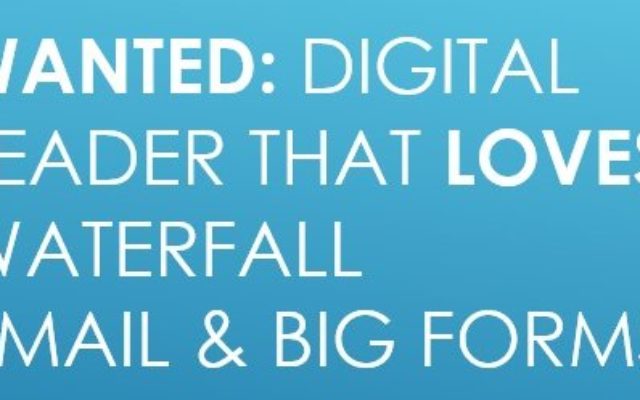Must love Waterfall techniques, email, form filling. No mobile experience necessary. Must have plenty of spare time. I have recently completed reading the excellent book The Goal by Eliyahu M. Goldratt which claims to have transformed management thinking. I am applying what I learned by reading this transformational book and as a result must abandon much of my leadership thinking.
I work as a Digital Transformational leader and have a lengthy career and management qualifications, so when a great opportunity comes up as a digital leader I might be interested in applying.
I measure processes by the effect they achieve rather than what they say they do. After all in the world of Agile that I work in, it is “show me the thing”, not “talk me through the documentation” and of course it is working code that is the primary measure of progress, not how many documents you have signed.
So I chose to apply my skills to learn how I need to adapt them to apply for digital leadership positions and found they were no use at all. I need to abandon agile and return to waterfall. I need to abandon collaborative working and return to email. I need to abandon small increments and instead go for big bang and finally I must abandon using my mobile phone and revert to using Microsoft Office on my desktop. It seems the digital leader of today is stuck in the 1990s. That is what the recruitment process optimises for, therefore it must be true.
Of course, that’s where I’ve been going wrong all the time. It’s obvious really. Try to recruit someone who is a digital leader, but put every obstacle in their way so that only people who are not digital leaders will be able to make it to the end of the process.
This is therefore a recruitment process that optimises for people who love Waterfall, Emails, Printouts, Microsoft Word, Filling In Long Forms.
You’re not really looking for a digital leader at all then, let’s be honest. It’s all a bit of a cover story for you looking for a waterfall-loving form-filling email-sending desktop-hugging digital-dinosaur. I understand. It’s OK, really and it must be really hard in a fast moving digital economy to still love those things, but you couldn’t possibly put them on a job advert – you’d be a laughing stock!
Imagine the conversations down the techhub – Ah, so and so is STILL DOING WATERFALL. In 2016!! THEY STILL USE PRINTERS!! That’s where careers go to die. Who would possibly want to work there?
Let’s go back to The Goal. It’s about optimising a process from sales to fulfilment. What is recruitment except a process of connecting talent with opportunity? Like The Goal, we should be aiming to maximise throughput, not have people drop out because the front door of the company makes them look like a digital dinosaur.
The recruitment process is the front door of a company and first impressions count. Whilst accepting that a digital transformation specialist is needed, therefore there is digital transformation work to do (and this includes recruitment) and that a difficult recruitment process might put off the people you most need.
This is especially true if they are busy, travelling and have limited time to deal with form filling, printing paper for signing and also in a competitive jobs market it might be easier for them to look elsewhere than go through a difficult process. Agencies express frustration to me about the time they invest in hiring a candidate only to find someone faster moving takes them off the market.
Some key areas to consider:
- Often job descriptions and details assume that the applicant is sitting at a desktop, whereas in reality most job seeking is now done on mobile. This means that if the candidate is on their mobile, the appropriate information needs to be readable. As a result, Word attachments for reading or Excel spreadsheets for completion are going to be a barrier for completion. Zooming in on a job description to see only a portion of it is not an optimal experience. A text based email would do the job better.
- Candidates nearly all have LinkedIn profiles and CVs and so asking for information which should be on any well written profile is duplication and takes time away from entering other more specific information. If you do need to give the candidate more information and this is generic, consider putting it on a website if it can be made public or in one mobile friendly document. If it’s more than a few documents it obstructs the user journey. Look to Amazon as an example – one click leads to sales and more than one click creates an opportunity to drop out of the process.
- When asking people for information, consider what value it adds to recruitment. In assessing someone for a position you need to know about their relevant skills and experience they can bring to the role as well as cultural fit. Whilst knowing where the candidate found out about the role might be useful to a recruiter, it isn’t useful to a candidate. Perhaps they bookmarked the application ealier in the day when browsing on their commute and by evening they retrieve the bookmark to complete the process. If such marketing information is optional then it doesn’t obstruct the candidate if they can’t remember. You will then get better quality information rather than a guess to get past the form. Candidates also don’t being liked some questions like “what was your previous salary” and doing so can perpetuate gender salary based discrimination.
- Consider the use of drop lists and other validation techniques. We all want quality data, but if the user has a valid qualification and your form doesn’t permit it, then the candidate will just get frustrated. Someone is going to have to read the form anyway, so rather than forcing validation, it might be better to have most of the fields as free text. I encountered a form once that didn’t allow me to say I was a Fellow of the BCS, which was disappointing as it was relevant to the role. A small drop list is helpful for mobile users but consider using “other” if there is likely to be exceptions to the list.
- Consider what data you need from the candidate. They might have been at conferences and there are links to presentations and videos online. Not only does this add to credibility that they have done these things, but posting them online and reading the comments adds hugely to the credibility of the content when peer reviewed.
- Remember that good candidates might not be on the market for long so the complexity of the recuitment process needs to be balanced with candidate availability and recruitment is a partnership in which the needs of the canidate should not be ignored. Other companies can move quickly and you might miss out if you take too long.
Recruitment doesn’t need to be slow and inefficient.
GDS, the subject of an earlier blog post has done a lot of great work to optimise user journeys. As a start, try out your recruitment process on someone else in the office to see where they get frustrated, lost or abandon.
It’s a pipeline from candidate to job. Let’s start to optimise the process for the people we most want to hire.
I suggest having some innovation and getting candidates, recruitment agencies, end-recruiters and even job boards all collaborating on a better solution which maximises success. Then we can get something that works for everyone, not just a local demand driven process that breaks for everyone upstream of the end-client.
If you think the same, please contact me, we can bring the movejobs.com project to life and together we can bring recruitment into the 21st century. Comments welcome!
Read more by Craig Cockburn, here
Article by channel:
Everything you need to know about Digital Transformation
The best articles, news and events direct to your inbox







